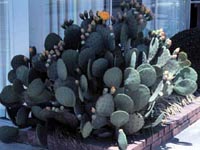Resource Library
Plant of the Week: Thornless Prickly Pear Cactus
The University of Arkansas System Division of Agriculture does not promote, support or recommend plants featured in "Plant of the Week." Please consult your local Extension office for plants suitable for your region.
Plant of the Week
Thornless Prickly Pear Cactus
Latin: Opuntia tuna

Luther Burbank and I seem to have something in common. That is, we just don’t understand
or quite trust for that matter, people who don’t like cactus.
Burbank, the famous turn of the century plant breeder who gave us the russet potato
we eat with our steaks, was a visionary plant breeder who saw potential where others
simply saw confusion. Burbank was an eclectic breeder who worked with hundreds of
different plants, but one of his most bizarre breeding attempts must be his effort
to produce the spineless prickly pear. Burbank (1849-1926) is not a very highly regarded
plant breeder, at least in academic circles, because he seemed to promote his "new
creations" in such a way that would make a used car salesman blush and his record
keeping skills were practically non-existent.
While Burbank, and his several ghost writers, produced lots of books including his
13-volume "How Plants are Trained to Work for Man," (published in 1914 and reissued
in 1921 as eight volumes) -- it is difficult to determine what species he used in
his various and sundry crosses.
Burbank’s cactus breeding seems to have begun in the closing years of the 19th Century.
For a Mr. Harwood, in his 1905 book, "New Creations in Plant Life," discusses the
project and promotes it profusely, but concludes that they are not quite fully ready
to be launched. Harwood says that the cactus will not be sold for profit, but by 1914
Burbank seems to have changed his mind for he says that a John Ruthland from Australia
paid him $1,000 for a single pad and "practically paid for his new home" from proceeds
of the sale.
Burbank first collected seeds or cuttings of all the spineless types he could acquire
and then, with the energy of a deranged bumble bee, crossed and re-crossed various
sorts until he achieved complete spinelessness. He released a dozen or more thornless
cacti with names such as "Gravity," "Royal," "Prolific," "Hemet" and "Melrose."
Burbank claimed that, not only did these selections produce seedlings that would
also be thornless, but that the cattle that fed on them would have no need for water,
because they could get all they needed from their forage. He proposed a feed-lot system
where the opuntia slabs, along with some alfalfa and bran, would be harvested and
hauled to the cattle so that the cattle did not destroy the plants as they grazed
on them. From his experiments at his own proving grounds Burbank estimated that he
would get 100 tons of production per acre.
Well, needless to say, opuntia never made it as a dry-land forage crop for the thirsty
parts of the world. As it turns out, thornlessness in cacti is in part genetically
controlled, but also environmentally controlled. When plants are stressed enough,
they sometimes will produce thorns so Burbank’s dream of million acre of cactus ranches
never was to be.
As an ornamental the prickly pear is an interesting specimen plant. Depending on
the selection, it can grow from 2- to 8-feet tall. Hybrids are hardy statewide in
Arkansas if they are given full sun and good drainage.
In summer, plants produces teacup-sized yellow blossoms that are followed by a fleshy,
edible fruit. While placing a prickly pear in the landscape so it looks appropriate
is always a challenge in our well-watered state, it can make an interesting conversation
piece as the story of Burbank and his big dream are told.
By: Gerald Klingaman, retired
Extension Horticulturist - Ornamentals
Extension News - October 29, 1999
The University of Arkansas System Division of Agriculture does not maintain lists of retail outlets where these plants can be purchased. Please check your local nursery or other retail outlets to ask about the availability of these plants for your growing area.